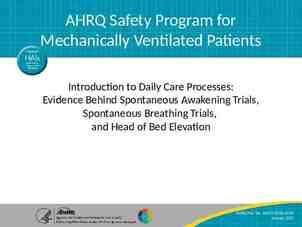Carbon Monoxide Poisoning, Smoke Inhalation, Cyanide Poisoning Condell
89 Slides233.00 KB

Carbon Monoxide Poisoning, Smoke Inhalation, Cyanide Poisoning Condell EMS System ECRN CE Module III 2009 Module III CE Site Code #107200-E-1209 Prepared by: Dan Ogurek, F/M Countryside Fire Protection District Sharon Hopkins, RN, BSN EMS Educator

Objectives Upon successful completion of this module, the ECRN will be able to: 1. Identify physical characteristics of CO 2. Identify sources of CO 3. Identify statistics of CO incidents 4. Identify pathophysiology of CO poisoning 5. Identify CO effects on hemoglobin 6. Identify CO effects on major body systems 7. Identify CO exposures and limits (ppm) 8. Discuss importance of being able to monitor CO levels for patients

Objectives cont’d 9. Identify signs/symptoms of CO poisoning and smoke inhalation 10. Identify the treatment of CO poisoning and smoke inhalation 11. Identify possible long term effects of CO poisoning 12. Identify the difference between acute and chronic CO poisoning 13. Identify complications related to smoke inhalation 15. Identify physical characteristics of cyanide 16. Identify common sources of cyanide

Objectives cont’d 17. Identify the pathophysiology of cyanide poisoning 18. Identify body tissues most susceptible to cyanide poisoning 19. Identify signs/symptoms of cyanide poisoning 20. Identify the OSHA permissible levels of cyanide 22. Discuss treatment of cyanide exposure 23. Successfully complete the post-quiz with a score of 80% or better

Carbon Monoxide (CO) An odorless, colorless, tasteless gas Results from incomplete combustion of carboncontaining fuels – Gasoline, wood, coal, natural gas, propane, oil, and methane Affects 40 – 50,000 Americans annually who need to seek care Kills an additional 6,000 persons annually in the USA CO is the #1 cause of poisoning in industrialized countries

Sources of Carbon Monoxide – any combustible item Homes Cigarette smoke House fires Automobile exhaust fumes Worksites – Including fumes from propane-powered equipment like forklifts Commercial structures Smoke from charcoal-fired cook stoves & ovens

Sources cont’d Heat provided to homes – Gas-fueled heaters – Wood burning stoves Indoor stoves Camp stoves Gas-powered generators Recreational environments Recreational vehicles Boat exhaust fumes

Carbon Monoxide Incidents Peak time of day 1800 – 2159 Overall, 75% of non-fire CO incidents are reported between 0900 and 2259 Peak months are December and January for non-fire CO incidents Almost 9/10 (89%) of non-fire CO incidents took place in the home Source: Non-Fire Carbon Monoxide Incidents Reported in 2005; NFPA Fact Sheet

What Effect Does Carbon Monoxide Have on Hemoglobin? Hemoglobin molecules each contain four oxygen binding sites Carbon monoxide binds to hemoglobin This binding reduces the ability of blood to carry oxygen to organs Hemoglobin occupied by CO is called carboxyhemoglobin Body systems most affected are the cardiovascular and central nervous systems

Effects of Carbon Monoxide Oxygen cannot be transported because the CO binds more readily to hemoglobin (Hgb) displacing oxygen and forming carboxyhemoglobin Premature release of O2 prior to reaching distal tissue leads to hypoxia at the cellular level Inflammatory response is initiated due to poor and inadequate tissue perfusion Myocardial depression from CO exposure – Dysrhythmias, myocardial ischemia, MI Vasodilation – from increased release of nitric oxide; worsening tissue perfusion and leading to syncope

Half-life of Carbon Monoxide Half-life – time required for half the quantity of a drug or other substance to be metabolized or eliminated CO half-life on 21% room air O2 – 4 - 6 hours CO half-life on 100% O2 – 80 minutes CO half-life with hyperbaric O2 – 22 minutes

CO Levels Fresh air 0.06 - 0.5 ppm Urban air 1 – 300 ppm Smoke filled room 2 – 16 ppm Cooking on gas stove 100 ppm Actively smoking 400 – 500 ppm cigarette Automobile exhaust 100,000 ppm

Expected Carboxyhemoglobin Levels Non-smokers – 5% Smokers – up to 10% – 5 – 6% for a 1 pack per day smoker – 7 - 9% for a 2-3 pack per day smoker – Up to 20% reported for cigar smokers Urban commuter – 5%

CO Poisoning Symptoms are often vague, subtle, and non-specific; can easily be confused with other medical conditions; – Flu – nausea, headaches – Food poisoning - nausea – Cardiac and respiratory conditions – shortness of breath, nausea, dizziness, lightheadedness CO enters the body via the respiratory system Poisoning by small amounts over longer periods of time or larger amounts over shorter time periods

Exposure Limits For CO OSHA – 50 ppm as an 8-hour-weighted average NIOSHA – 35 ppm as an 8-hourweighted average – Set lower than OSHA based on cardiac effects of CO

Fire Department Screening Take – – – – – a reading at the scene Evaluate particular areas especially prone to CO levels Advice the caller based on readings taken Results reported in “ppm” Departments use the NIOSH reading level of 35 ppm as the lower limit of normal Will assess the patient for signs and/or symptoms Important to maintain high index of suspicion May call into the ED reporting the ppm findings

Symptoms of CO Poisoning Related to Levels and Exposure Time 50 ppm – no adverse effects with 8 hours of exposure (OSHA limit) 200 ppm – mild headache after 2-3 hours 400 ppm – serious headache and nausea after 1-2 hours (life-threatening 3 hours) 800 ppm – headache, nausea, dizziness after 45 minutes; collapse and unconsciousness after 2 hours; death within 2-3 hours 1000 ppm – loss of consciousness after 1 hour

Levels & Exposure Time Cont’d Source: NFPA Fire Protection Handbook, 20 th Edition 1600 ppm – headache, nausea, dizziness after 20 minutes; death within 1 hour 3200 ppm – headache, nausea, dizziness after 5-10 minutes; collapse and unconsciousness after 30 minutes; death within 1 hour 6400 ppm – headache, dizziness after 1-2 minutes; unconsciousness and danger of death after 10 -15 minutes 12,800 ppm – immediate physiological effects; unconsciousness and danger of death after 1-3 minutes

Carbon Monoxide Absorption Dependent upon: – Minute ventilation Amount of air exchanged in the lungs within one minute – Duration of exposure The longer the exposure, the more the absorption – Concentration of CO in the environment The higher the concentration, the greater the toxicity – Concentration of O2 in the environment The lower the O2 concentration to begin with, the faster the symptoms will develop – higher altitudes – closed spaces

Assessment for CO Exposure EMS may be summoned to monitor the air quality for the presence of carbon monoxide – Airborne CO meters are used and documentation made whether there is a patient transport or not A more immediate concern is the level of CO in the patient’s blood – – RAD 57 monitors are a non-invasive tool that allows results in less than 30 seconds Rapid diagnosis leads to rapid and appropriate treatment

RAD 57 Device Used like a pulse ox Non-invasive tool Readings within seconds Helps to quickly hone in a diagnosis Used in ED and in the field

Masimo Rad-57 Consider cyanide poisoning in presence of smoke/fire situations No order necessary to take a CO reading At CMC – Mounted on roller stand; must be kept plugged in – Stored in “Equipment Room” with IV pumps At LFH – Mounted on roller stand; must be kept plugged in – Stored in Room #1 At Grayslake Freestanding Emergency Center – Not available

Masimo Rad-57 Guidelines The following are broad guidelines Treat the patient SpCO – – level readings SpCO levels 5% Normal in non-smokers; no treatment SpCO levels 5% 5-10% normal in smokers In non-smokers, treat with 100% O 2 EMS should be transported for further evaluation

Rad-57 Guidelines cont’d – SpCO levels 10% 100% O2 and ED transport Assess – the signs and symptoms SpCO levels 25% 100% O2 and ED transport Consider chamber a facility with hyperbaric

CO Levels with Related Signs and Symptoms 5% - mild headache 6-10% - mild headache, SOB with exertion 11-20% - moderate headache, SOB 21-30% - worsening headache, nausea, dizziness, fatigue 31-40% - severe headache, vomiting, vertigo, altered judgment 41-50% - confusion, syncope, tachycardia 51 – 60% - seizures, shock, apnea, coma

Signs and Symptoms CO Poisoning Carboxyhemoglobin Mild levels of 15 – 20% severity Headache – mild to moderate Shortness of breath Nausea and vomiting Dizziness Blurred vision

Signs and Symptoms CO Poisoning Carboxyhemoglobin levels of 21 – 40% Moderate severity Worsening headache Confusion Syncope Chest pain Dyspnea Tachycardia Tachypnea Weakness

Signs and Symptoms CO Poisoning Carboxyhemoglobin levels of 41 - 59% Severe Dysrhythmias, palpitations Hypotension Cardiac ischemia Confusion Respiratory arrest Pulmonary edema Seizures Coma Cardiac arrest

Signs and Symptoms CO Poisoning Carboxyhemoglobin levels of 60% Fatal Death Cherry red skin is not listed as a sign – An unreliable finding

Increased Risks Health and activity levels can increase the risk of signs and symptoms at lower concentrations of CO – Infants – Women who are pregnant Fetus at greatest risk because fetal hemoglobin has a greater affinity for oxygen and CO compared to adult hemoglobin – Elderly – Physical conditions that limit the body’s ability to use oxygen Emphysema, asthma Heart disease – Physical conditions with decreased O2 carrying capacity Anemia – iron-deficiency & sickle cell

Risks to Firefighters from CO Exposure On – – – – – the job from repeated exposures Structure fires Apparatus fumes Portable equipment fumes Gasoline powered saws Generators Premature removal of SCBA equipment increases the risk of exposure

CO Identification Sooner the suspicion the sooner the appropriate treatment can be initiated Complications to monitor – Seizures – Cardiac dysrhythmias – Cardiac ischemia

CDC Diagnostic Criteria Suspected – Potentially exposed person but no credible threat exists Probable – CO exposure Clinically compatible case where credible threat exists Confirmed – CO exposure CO exposure Clinically compatible case where biological tests have confirmed exposure

Patient Assessment Continuously – monitor SpO2 and SpCO levels Remember that SpO2 may be falsely normal If EMS has used a CO-oximeter, findings to be reported to the ED staff Generally, results 3% indicate suspicion for CO exposure in non-smoker Cardiac monitor 12 lead EKG obtained and transmitted to ED –

Pulse Oximetry Device to analyze infrared signals Measures the percentage of oxygenated hemoglobin (saturated Hgb) Can mistake carboxyhemoglobin for oxyhemoglobin and give a false normal level of oxyhemoglobin Never rely just on the pulse oximetry reading; always correlate with clinical assessment

Pulse CO-oximeter Device Hand-held device Attaches to a finger tip similar to pulse ox device Most commonly measured gases in commercial devices include – Carbon monoxide (SpCO) – Oxygen (SpO2) – Methemoglobin (SpMet) – Other combustible gases Without the device, need to draw a venous sample of blood to test for CO levels

Pulse CO-oximeter Tool Firefighters – – – have an increased exposure risk Active firefighting Inhaled products of combustion in structure fire Inhaled exhaust from vehicles and power tools

Treatment CO Poisoning Increasing the concentration of inhaled oxygen can help minimize the binding of CO to hemoglobin Some CO may be displaced from hemoglobin when the patient increases their inhaled oxygen concentrations Treatment begins with high index of suspicion and removal to a safer environment Immediately begin 100% O2 delivery

Treatment CO Poisoning Guidelines from different sources may vary when to initiate treatment based on SpCO levels – Report levels to the ED MD Remember 5% in non-smokers is abnormal Treatment levels vary significantly – If you do not have a CO-oximeter to use, maintain a heightened level of suspicion and base treatment on symptoms Monitor for complications – – – Seizures Cardiac dysrhythmias Cardiac ischemia

CO Poisoning and CPAP CPAP could assist in fully oxygenating hemoglobin If considered, EMS to contact Medical Control for permission to use CPAP – The ECRN would need to relay report to the ED MD to obtain an order for CPAP

Long Term Effects CO Exposure Hypoxemia follows CO exposure Effects of hypoxemia from CO exposure is dependent on presence of underlying diseases Hypoxemia can cause the formation of free radicals – dangerous chemicals

Long Term Cardiovascular Effects Myocardial injury from hypoxia and cellular damage – Pump failure – Cardiac ischemia – Later development cardiovascular complications – Premature death especially if myocardial damage at the time of initial exposure Factors increasing myocardial injury risk – Male gender – History hypertension – GCS 14 when patient first found

Long Term Neurological Effects Effects are primarily affective (mood) and cognitive (thought) – Increased depression and anxiety regardless if exposure accidental or suicidal attempt – Phenomenon called delayed neurological syndrome (1 - 47% of cases) More likely if there was a loss of consciousness Behavioral and neurological deterioration Memory loss, confusion, ataxia, seizures, urinary & fecal incontinence, emotional lability, disorientation, hallucinations, mutism, cortical blindness, psychosis, gait disturbances, Parkinsonism

Increased Risk to Firefighters CO and other poisonous gas exposure present to the occupation – Often the SCBA is not worn through all phases of fire operations Most duty-related firefighter deaths result from cardiovascular disease – Increased risks in this population Smoking Obesity Lack of exercise Dietary issues Studies have not correlated chronic CO exposure with additional risk factors – just something to consider

Methylene Chloride Product used in industry as a paint and adhesive remover. Repetitive and prolonged exposure can result in development of CO – Slowly metabolized to CO in the liver following exposure Contamination – risk to rescuer Patient’s clothing, skin, vomitus from off-gassing Watch for same signs & symptoms as CO Treatment – high flow oxygen therapy

Smoke Inhalation Expect inhalation injury when patients are trapped or unconscious in an enclosed space – Can also occur in open space if smoke is dense enough Enclosed space inhalation hazards – Noxious, poisonous gases – Heated air – Flames – Steam

Signs and Symptoms Smoke Inhalation Hoarseness Dyspnea Stridor (high-pitched crowing) on inspiration Singed facial and nasal hair Black-tinged (carbonaceous) sputum Facial burns

Assessment for Smoke Inhalation Monitoring pulse oximetry Frequently reassessing vital signs – – Watch for changes in the respiratory system Frequently reassess breath sounds listening for any changes Listen – If for changes in tone of speech Hoarseness will develop CO-oximeter available, evaluate for the presence of CO

Treatment for Smoke Inhalation With suspected thermal or chemical airway burns, airway compromise is highly potential Intubation needs to be considered and prepared for Administer 100% O2 as soon as possible – – Treats hypoxia Displaces CO, if present, from hemoglobin Establish IV access

Complications of Smoke Inhalation Swelling of the highly vascular tissues – Airway restrictions – Severe dyspnea – Respiratory arrest In any environment where carbon monoxide is present, cyanide should be suspected

Cyanide Poisoning Cyanide can be any of various salts or esters of hydrogen cyanide containing a CN group – Contains especially poisonous compounds potassium cyanide and sodium cyanide Rapidly fatal without an antidote

Physical Characteristics Cyanide Colorless gas with a faint smell of bitter almonds – 40% of population cannot smell cyanide Can be ingested or inhaled

Sources Cyanide Found during combustion of plastics, wool, silk, synthetic rubber, polyurethane, asphalt Most accidental exposure is to cyanide gas Most intentional exposure (ie: suicide or homicide attempts) are to cyanide powder

OSHA Permissible Levels of Cyanide 10 ppm as an 8-hour timeweighted average

Pathophysiology of Cyanide Effects Cyanide is a cellular toxin Inhibits an enzyme involved in energy production in the cells (ATP) Cells shift from aerobic to anaerobic metabolism Energy production dramatically decreased

Susceptible Body Tissues to Cyanide Cardiovascular and central nervous system most affected body systems Exposure is rapidly fatal unless antidote quickly administered

Signs and Symptoms Cyanide Exposure Levels measured as the methemoglobin level 1-3% - asymptomatic 3-15% - slight grayish-blue skin discoloration 15-20% - asymptomatic, but cyanotic 25-50% - headache, dyspnea, confusion, weakness, chest pain 50-70% - altered mental status, delirium

Early Signs of Low Exposure to Cyanide Rapid breathing Dizziness Weakness Nausea and vomiting Eye irritation Pink or red skin color Increased heart rate Perspiration

Later Signs of Exposure to ModerateHigh Concentrations of Cyanide Loss of consciousness Respiratory arrest Cardiac arrest Coma Seizures

Monitoring for Cyanide Levels Not measurable on standard, hand-held, non-invasive devices Must be evaluated for in a hospital setting where a lab draw can be performed and results tested in the laboratory For these reasons, health care workers must maintain a high level of suspicion and treat on the assumption of its presence

Cyanide Antidote Kit Contents – Nitrites can be dangerous when administered in the presence of additional CO poisoning – – – Amyl nitrite, sodium nitrite, sodium thiosulfate Oxygen can only bind with the heme (iron) molecule in the ferrous state When hemoglobin converts to methemoglobin, the heme molecule changes to the ferric state of iron Nitrites induce formation of methemoglobin (form of hemoglobin that does not bind/carry oxygen) Nitrites not to be given when SpCO is 10% Nitrites can also cause hypotension

Signs and Symptoms Methemoglobinemia 1-3% SpMet – normal, asymptomatic 3-15% SpMet – slight grayish-blue skin 15 – 20% - asymptomatic but cyanotic 25 – 50% - headache, dyspnea, confusion, weakness, chest pain 50 -70% - altered mental status, delirium Methemoglobinemia is also a complication when Benzocaine (to decrease the gag reflex) is used even under normal 2 second spray time frame

Cyanokit This kit uses hydroxocobalamin – – – Preferred kit if concomitant CO and cyanide poisoning suspected – – – A form of Vitamin B12 (cyanocobalamin) Binds with the cyanide ion Eliminated through the kidneys Significant signs and symptoms with low CO levels Decreased cardiac output, decreased heart rate Hypotension, shock, and falling ETCO2 levels Signs & symptoms of CO and cyanide poisoning indistinguishable

Cyanokit Availability At – – At – At – CMC In ED pyxis in Zone 1 In pharmacy LFH In ED pyxis Grayslake Free Standing Emergency Center In ED pyxis

Case Study Review Review the following cases. What is your assessment? – Think out-of-the-box What would be your treatment? Should EMS transport this patient?

Case Study #1 EMS is called for a 42 year-old male in a factory experiencing heat exhaustion Pt confused, agitated, sweating VS within normal limits What are your general impressions/suspicions? What is included in your assessment? What is your treatment?

Case Study #1 The patient appears to be experiencing a heat related problem and the environment may support this suspicion but consider other possibilities as well. Perform as much evaluation as you have equipment for – – – CO levels Glucose levels Head injuries

Case #1 - Summary Patient’s CO level was 9% The work environment was evaluated – – A 40- 55 ppm Up to 556 ppm the farther into the building Ems walked faulty outlet from a propane and gasoline operated power lift was found All employees evacuated and those with complaints were evaluated

Case Study #2 72 year-old male patient driving erratically and had struck a parked car Pt alert, confused, complaining of a headache, nausea, weakness and dizziness with evidence of vomitus on his shirt VS normal range; no signs of trauma What are your general impressions/suspicions? What is included in your assessment? What is your treatment?

Case #2 Again, many possibilities for this behavior – – – – – Hypoglycemia Head injury ETOH CO exposure Could be normal for this patient Evaluate vital signs and neurological signs Evaluate glucose level Evaluate Cincinnati stroke scale Evaluate for a CO level if you have a CO-oximeter

Case #2 - Summary CO level 40%; SpO2 94% The invalid wife at home was contacted – Wife asymptomatic Faulty exhaust system was found on car

Case #3 EMS responded to a local banquet hall for ill persons 5 guests complaining of dizziness, weakness, and nausea. All patients were from the same event; no illnesses from other simultaneous banquet What are your general impressions/suspicions? What is included in your assessment? What is your treatment?

Case #3 The party goers all thought they had suffered from food poisoning As word spread, more patients presented to EMS with complaints A multiple patient incident plan was put into place When rescuers began to become ill, CO was suspected and tested for

Case #3 - Summary CO – levels were found to be elevated Over 1000 ppm in the kitchen area Evacuation was performed Reentry into the scene for EMS with SCBA in place EMS activated the Multiple Patient Plan with the Resource Hospital

Multiple Patient Plan – Class I Business as usual EMS to meet normal level of care EMS to contact their closest hospital Report will be called in on every patient Run reports will be written for every patient

Multiple Patient Plan – Class II More chaotic at scene, more patients, more manpower EMS unable to meet normal level of care Resource Hospital (CMC) contacted for patient disposition directions CMC to coordinate transportation destination of patients – – CMC will contact area hospitals for ED bed availability Each facility to evaluate their capacity to take patients Triage tags used No radio report will be given – Transportation to inform the Resource Hospital when the patient is leaving the scene and the destination

Multiple Patient Incident Resource sheets by the EMS radio – Region X Multiple Patient Management Plan Coordinate response with – ED Charge RN – ED MD – Administrative representation Shift supervisor Administrator on-call Consider activating an internal disaster plan – Determine what kind and how many resources are needed

Case #3 – Multiple Patient Plan If CMC presented with multiple Category I trauma or medical patients – – – – CMC to evaluate how many Category / Critical patients they can take Thought process – do the best for the most Involve ED MD in decision making Resource Hospital to be contact with the scene Keep open communication to facilitate rapid disbursement of patients from the scene to hospital(s) used

Case #4 EMS received a call from a 10 year-old child that he could not wake up his mother. On arrival the 34 year-old female was unconscious with signs of seizure activity. 2 other children were in the home. What are your general impressions/suspicions? What is included in your assessment? What is your treatment?

Case #4 Upon EMS scene arrival, a faint odor of exhaust was noted Patient assessment included evaluation of normal reasons for altered level of consciousness including history of seizure disorder and suicide attempt After 5 minutes on scene, rescue personnel began complaining of headache A car was found running in the garage directly under the bedroom/bathroom
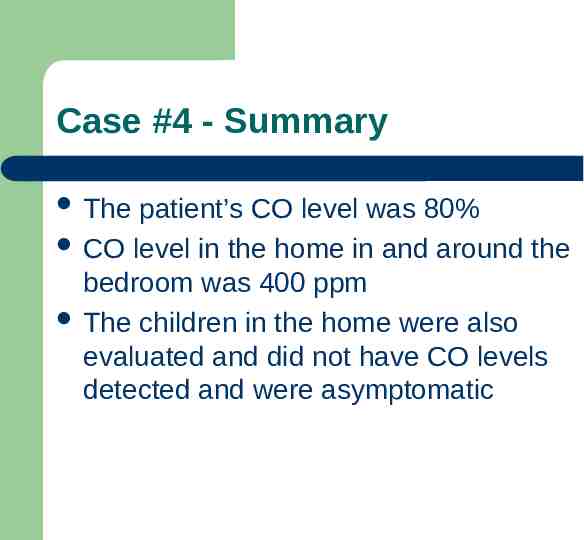
Case #4 - Summary The patient’s CO level was 80% CO level in the home in and around the bedroom was 400 ppm The children in the home were also evaluated and did not have CO levels detected and were asymptomatic
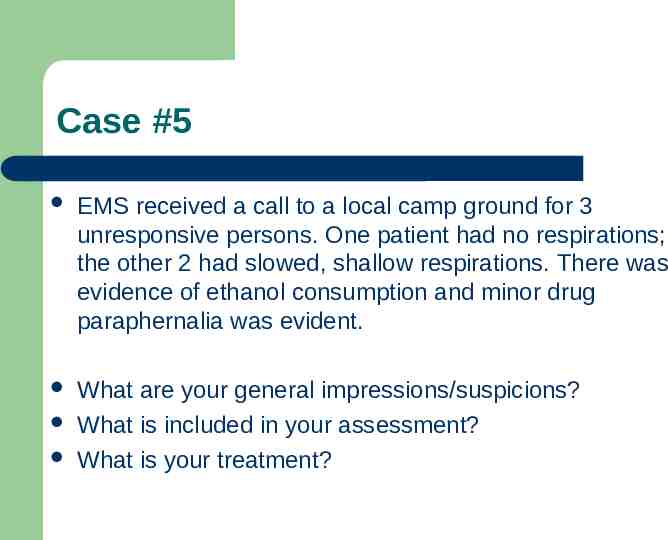
Case #5 EMS received a call to a local camp ground for 3 unresponsive persons. One patient had no respirations; the other 2 had slowed, shallow respirations. There was evidence of ethanol consumption and minor drug paraphernalia was evident. What are your general impressions/suspicions? What is included in your assessment? What is your treatment?
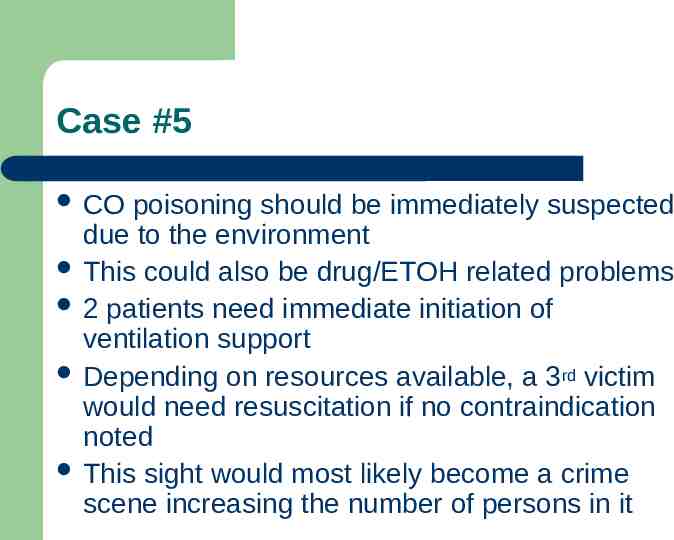
Case #5 CO poisoning should be immediately suspected due to the environment This could also be drug/ETOH related problems 2 patients need immediate initiation of ventilation support Depending on resources available, a 3 rd victim would need resuscitation if no contraindication noted This sight would most likely become a crime scene increasing the number of persons in it
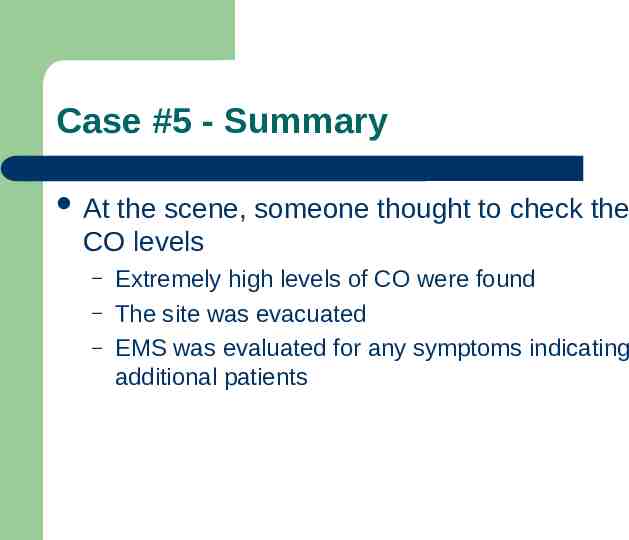
Case #5 - Summary At the scene, someone thought to check the CO levels – – – Extremely high levels of CO were found The site was evacuated EMS was evaluated for any symptoms indicating additional patients
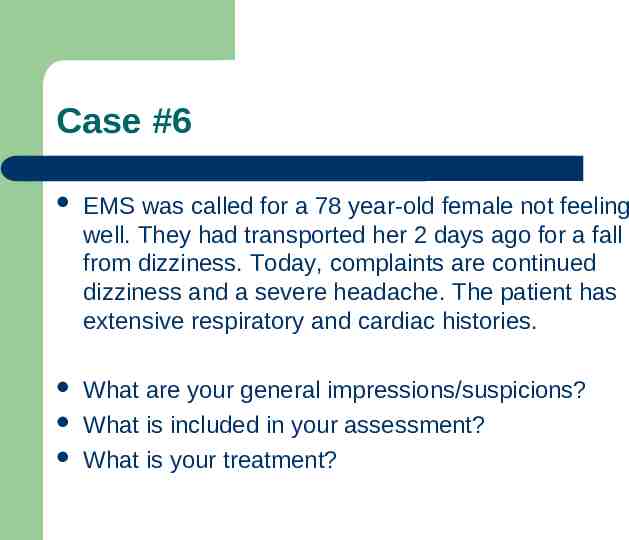
Case #6 EMS was called for a 78 year-old female not feeling well. They had transported her 2 days ago for a fall from dizziness. Today, complaints are continued dizziness and a severe headache. The patient has extensive respiratory and cardiac histories. What are your general impressions/suspicions? What is included in your assessment? What is your treatment?
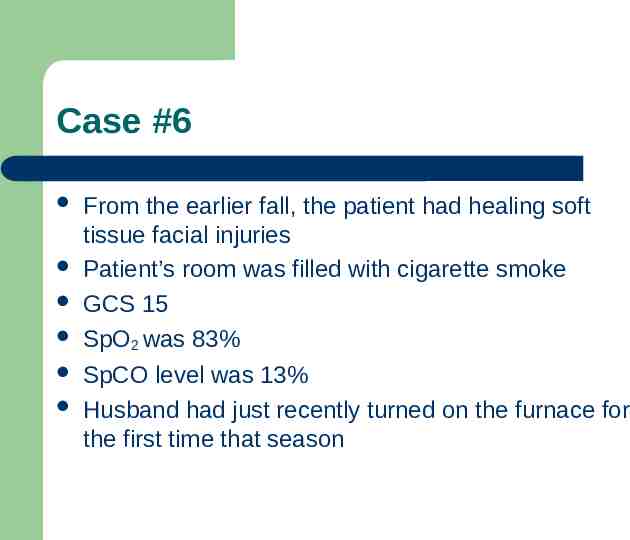
Case #6 From the earlier fall, the patient had healing soft tissue facial injuries Patient’s room was filled with cigarette smoke GCS 15 SpO2 was 83% SpCO level was 13% Husband had just recently turned on the furnace for the first time that season
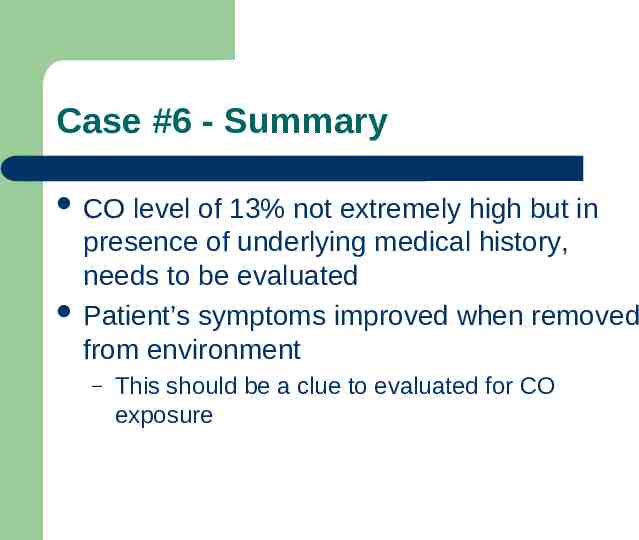
Case #6 - Summary CO level of 13% not extremely high but in presence of underlying medical history, needs to be evaluated Patient’s symptoms improved when removed from environment – This should be a clue to evaluated for CO exposure
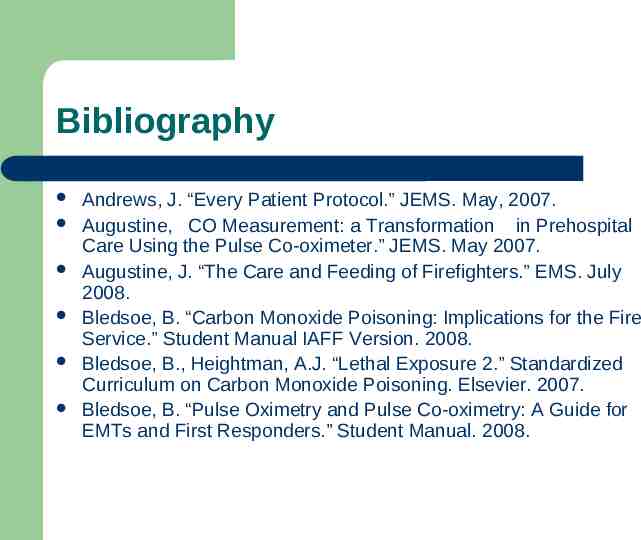
Bibliography Andrews, J. “Every Patient Protocol.” JEMS. May, 2007. Augustine, CO Measurement: a Transformation in Prehospital Care Using the Pulse Co-oximeter.” JEMS. May 2007. Augustine, J. “The Care and Feeding of Firefighters.” EMS. July 2008. Bledsoe, B. “Carbon Monoxide Poisoning: Implications for the Fire Service.” Student Manual IAFF Version. 2008. Bledsoe, B., Heightman, A.J. “Lethal Exposure 2.” Standardized Curriculum on Carbon Monoxide Poisoning. Elsevier. 2007. Bledsoe, B. “Pulse Oximetry and Pulse Co-oximetry: A Guide for EMTs and First Responders.” Student Manual. 2008.
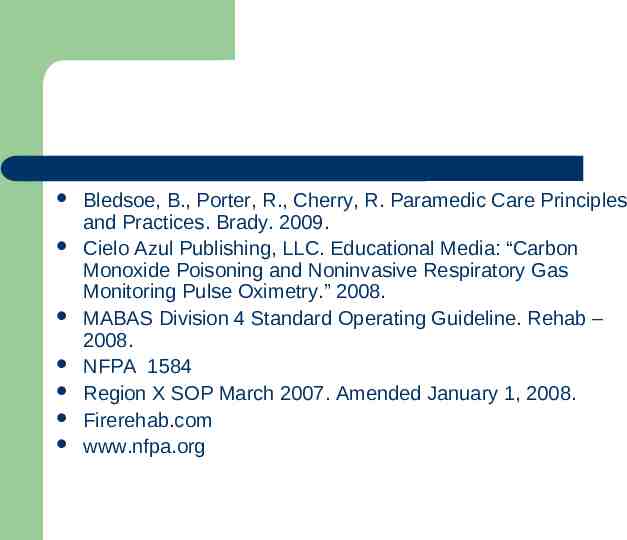
Bledsoe, B., Porter, R., Cherry, R. Paramedic Care Principles and Practices. Brady. 2009. Cielo Azul Publishing, LLC. Educational Media: “Carbon Monoxide Poisoning and Noninvasive Respiratory Gas Monitoring Pulse Oximetry.” 2008. MABAS Division 4 Standard Operating Guideline. Rehab – 2008. NFPA 1584 Region X SOP March 2007. Amended January 1, 2008. Firerehab.com www.nfpa.org


